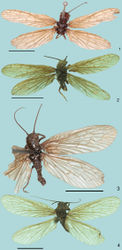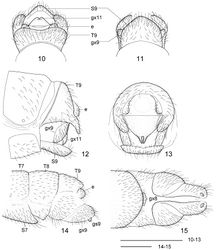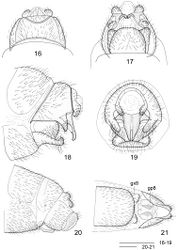Leptosialis
| Notice: | This page is derived from the original publication listed below, whose author(s) should always be credited. Further contributors may edit and improve the content of this page and, consequently, need to be credited as well (see page history). Any assessment of factual correctness requires a careful review of the original article as well as of subsequent contributions.
If you are uncertain whether your planned contribution is correct or not, we suggest that you use the associated discussion page instead of editing the page directly. This page should be cited as follows (rationale):
Citation formats to copy and paste
BibTeX: @article{Price2012ZooKeys201, RIS/ Endnote: TY - JOUR Wikipedia/ Citizendium: <ref name="Price2012ZooKeys201">{{Citation See also the citation download page at the journal. |
Ordo: Megaloptera
Familia: Sialidae
Name
Leptosialis Esben-Petersen – Wikispecies link – Pensoft Profile
- Leptosialis Esben-Petersen, 1920: 502. Type species: Leptosialis africana Esben-Petersen, 1920: 502 (original designation).
Diagnosis
The adults of Leptosialis are characterized by the following morphological traits: the narrowly elongated forewing, which is about 3.0–4.0 times longer than wide; the distally branched Rs; the MA either unbranched, bifurcated or trifurcated; the MP distally branched or with one or both main branches bifurcated; the male 9th tergum with a pair of posterolateral, digitiform processes; the paired ectoproct; the 11th gonocoxite in caudal view ventrally with a pair of acute, hook-like processes. At present no characters can be used to distinguish the larvae of the genus Leptosialis from other alderfly genera, many of which currently lack larval description.
Description
Adults (Figs 1–4).
Forewing length ~8–11 mm in males; ~11–12 mm in females. Body: generally brown or blackish-brown. Head: antenna pilose approximately half the length of the forewing; ocelli absent, or represented by three very small tubercles on vertex; labrum ~4.0–5.0 times wider than long, lateral margins rounded, front margin slightly emarginated. Prothorax > two times wider than long. Legs: yellow or dark brown, bearing dense setae; tarsal claws reddish brown. Wings: Forewing 3.0-4.0 times longer than wide, minutely hirsute, margins pilose; costal area broadened basally; subcostal area with five to eight distinct costal crossveins proximally; sc-r absent; Rs distally branched, MA either unbranched, bifurcated or trifurcated, MP distally branched or with one or both main branches bifurcated, CuA bifurcated; three or four crossveins between R and Rs. Hindwing as broad or slightly broader than forewing, about 3.0 to 3.5 times as long as wide; two or three distinct costal crossveins proximally; venation similar to forewing, with three crossveins between R and Rs. Male genitalia: 9th tergum transversely arched, with a pair of posterolateral, digitiform processes; ectoproct paired, small, roundly inflated ventrad; 11th gonocoxite in caudal view ventrally with a pair of acute, hook-like processes. Female genitalia: 7th sternum broad, posterior margin distinctly produced; 9th gonocoxite broad, apex bearing small, stout gonostylus.
Larvae (Figs 22–23).
Head: yellow to reddish brown. Thorax: pro-, meso- and metathorax orange to reddish brown, with distinct reticulated patterns of yellowish marks. Legs: pale yellow, bearing dense setae; tarsal claws reddish brown; Abdomen: dark purplish or blackish brown dorsally with paired, pale, submedian, comma-shaped marks on each segment; anal prolegs and hooked claws absent; elongated caudal filamentous appendage present; 7 pairs of pale yellow lateral abdominal gills present.
Remarks
The genus Leptosialis is the only representative of the Sialidae in South Africa. Because wing venation is quite different between the two Leptosialis species, it is difficult to find a stable morphological diagnosis for this genus. The male ninth tergum with a pair of digitiform processes could be the most important character to distinguish Leptosialis from its closely related genera, Stenosialis and Austrosialis.The two species may be distinguished using the following key.
Key to Leptosialis
Taxon Treatment
- Price, B; Liu, X; Moor, F; Villet, M; 2012: A review of the alderfly genus Leptosialis Esben-Petersen (Megaloptera, Sialidae) with description of a new species from South Africa ZooKeys, 201: 27-40. doi
Other References
- ↑ Barnard K (1931) The Cape alder-flies. Transactions of the Royal Society of South Africa 29: 169–184.
- ↑ Crass R (1949) Records of alderflies (Megaloptera) from Natal and the Eastern Cape, with a description of the larva of Leptosialis africana (E.-P.). Annals of the Natal Museum 11 (3): 519-522.
Images
|




